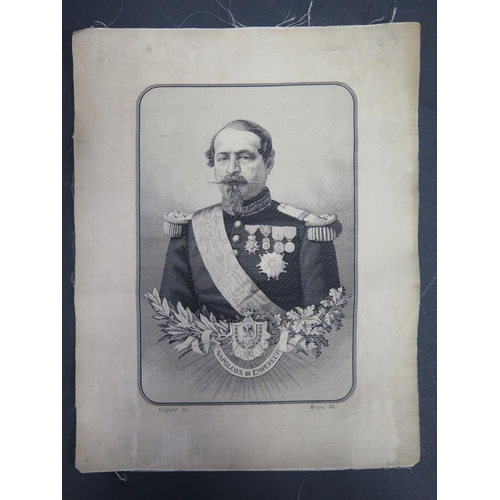JACQUARD WOVEN PORTRAIT: THE MOST FAMOUS IMAGE IN THE EARLY HISTORY OF COMPUTING.JACQUARD, JOSEPH-MARIE. 1752-1834. Woven silk portrait, 476 x 323 mm, Rüti, Zürich: Maschinefabrik Rüti, c.1847, Drawn by Fritz Kaeser after the original painting by Jean-Claude Bonnefond mounted to board, framed.
SWISS WEAVING OF THE FAMOUS BONNEFOND PAINTING.
Jacquard's loom, a mechanical loom that used a series of punched cards that corresponded to an intended design, would go on to revolutionize not only the textile industry but, with its programmable nature, would go on to have a major influence on computing, directly influencing Charles Babbage who used Jacquard punched cards in the design of his Analytical Engine. Ada Lovelace had pointed out: "We may say most aptly that the Analytical Engine weaves algebraical patterns just as the Jacquard-loom weaves flowers and leaves."
The city of Lyon commissioned Bonnefond to paint the Jacquard portrait in 1831 and later Lyon manufacturer Didier Petit et Cie commissioned the first silk version. This Swiss version dates from some years later and would have been produced both as an homage and to showcase the mechanical weaving abilities of Maschinenefabrik Rüti under the direction of Caspar Honneger.
JACQUARD WOVEN PORTRAIT: THE MOST FAMOUS IMAGE IN THE EARLY HISTORY OF COMPUTING.JACQUARD, JOSEPH-MARIE. 1752-1834. Woven silk portrait, 476 x 323 mm, Rüti, Zürich: Maschinefabrik Rüti, c.1847, Drawn by Fritz Kaeser after the original painting by Jean-Claude Bonnefond mounted to board, framed.
SWISS WEAVING OF THE FAMOUS BONNEFOND PAINTING.
Jacquard's loom, a mechanical loom that used a series of punched cards that corresponded to an intended design, would go on to revolutionize not only the textile industry but, with its programmable nature, would go on to have a major influence on computing, directly influencing Charles Babbage who used Jacquard punched cards in the design of his Analytical Engine. Ada Lovelace had pointed out: "We may say most aptly that the Analytical Engine weaves algebraical patterns just as the Jacquard-loom weaves flowers and leaves."
The city of Lyon commissioned Bonnefond to paint the Jacquard portrait in 1831 and later Lyon manufacturer Didier Petit et Cie commissioned the first silk version. This Swiss version dates from some years later and would have been produced both as an homage and to showcase the mechanical weaving abilities of Maschinenefabrik Rüti under the direction of Caspar Honneger.















Testen Sie LotSearch und seine Premium-Features 7 Tage - ohne Kosten!
Lassen Sie sich automatisch über neue Objekte in kommenden Auktionen benachrichtigen.
Suchauftrag anlegen